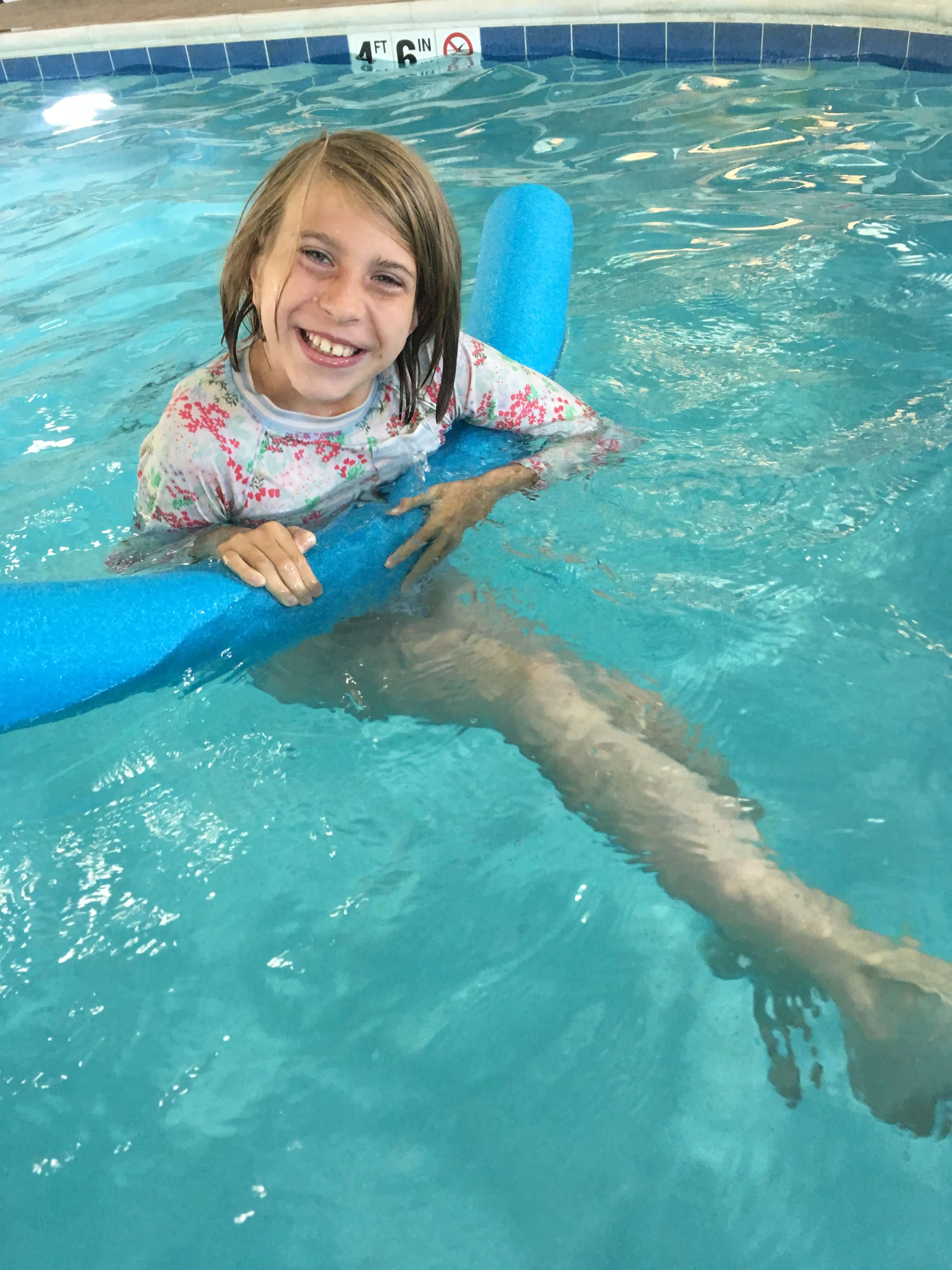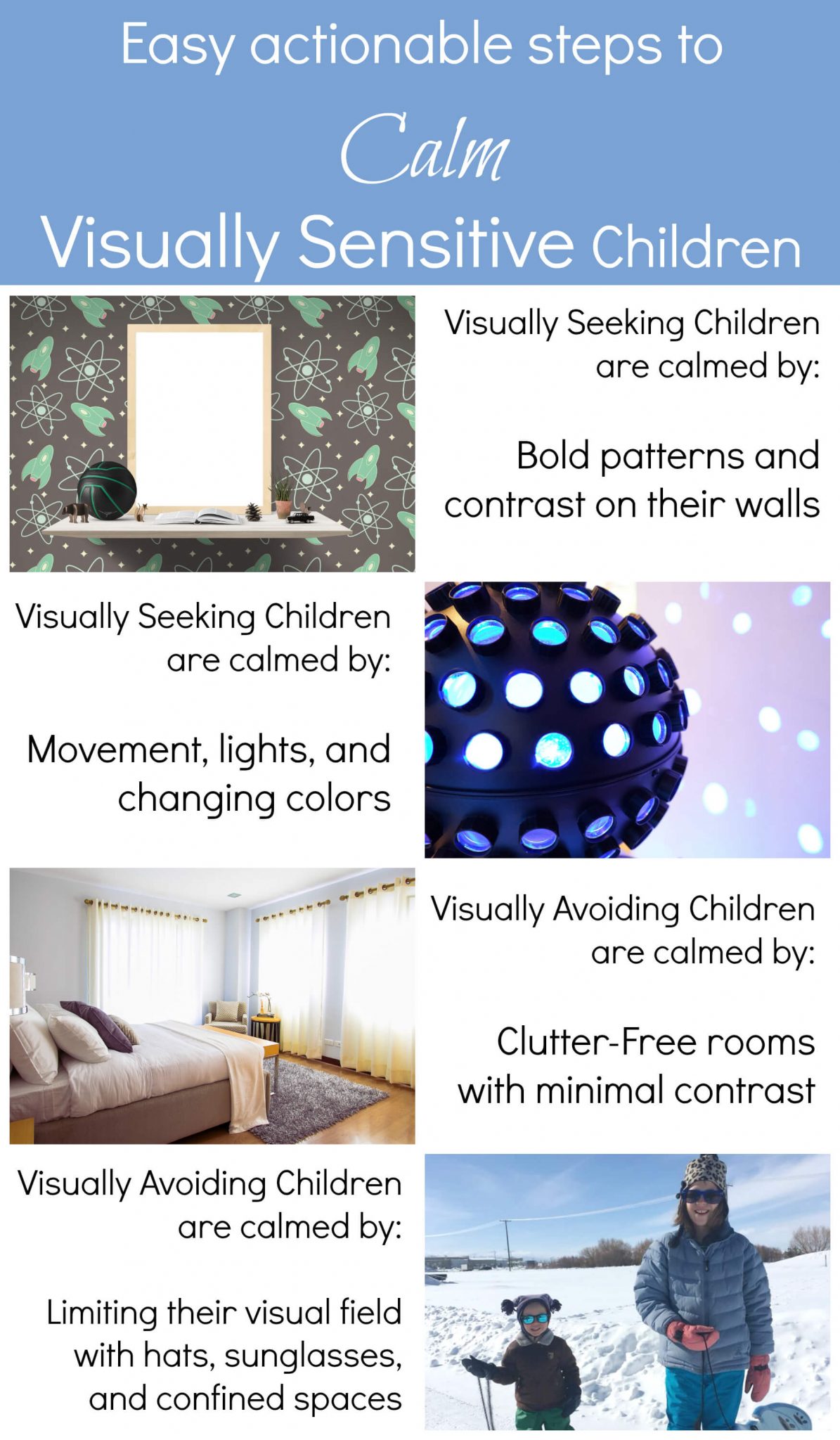
Sensory activities, and providing a varied sensory diet is one of my favorite ways to reduce children’s stress, minimize meltdowns, promote learning, and increase household happiness. Below we will talk about how to minimize overwhelm, or provide needed stimulation for those who either avoid visual sensory input.
Never heard of sensory integration issues?
Click here to see how they may be causing your child’s meltdowns.
Not sure where your child falls on the sensory spectrum?
Take the sensory quiz here.
Visually avoidant and visually seeking children are two sides of the same coin – they both are processing visual sensory information differently than most of the rest of us. We’ll talk at the end about what to do if you have children who share a room or a home and have opposite sensory needs as well.
⇢⇢⇢ Already know all this and want to skip to the tips? Click here!

Sensory issues are increasing
This current generation of children is experiencing sensory issues at a much higher rate. I suspect it’s due to the amount of toxins in our food supply and environment, overuse of antibiotics, premature births, and generational nutrient depletion. We will go more into this another time, but for now, we treat sensory issues symptomatically.
Yes, the GAPS Diet did help my daughter’s sensory issues enormously, and she has much less now at 11 than she did as a toddler.
Parents can work with their children’s sensory needs during daily activities and in their home environment.
This means we provide needed sensory input, or take away other sensory input so that these children are less stressed and can go about daily activities like learning, playing, and resting.
Occupational Therapy
If your child has severe sensory issues, or is on the autism spectrum, it’s likely that you are working with an occupational therapist. Your occupational therapist should be able to help you come up with more ideas to help your individual child. If you’d like to learn more about occupational therapy for sensory integration dysfunction, you can watch my video here.
Caretaker frustration
I’ll be honest- having a child with sensory needs, especially if they are severe, can be incredibly frustrating as a caretaker. This goes for babysitters, parents, teachers, and so on.
Occasionally I have seen adults at the end of their rope use sensory activities and needs as a way to punish or reward a child. This can be trying to force a solution onto a melting down child, “HERE! I bought you these sunglasses, now STOP IT”, or subjecting a child who is sensory avoidant to a sensation they hate (putting a child who hates the sensation of touching sand in a sandbox, etc).
This is absolutely not okay. Sensory activities are meant to be a gentle regulating activity. They are not to be used in anger, as punishment, or to solve all your problems. You cannot blame the child, it is out of their control.
Children are very sensitive to the emotions of their caretaker, and sensory activities done while the caretaker is angry, stressed, or overwhelmed will backfire. If this is the case, it is better to get the child to a safe and preferred environment, and calm yourself down first.
Parents who are constantly helping their children regulate are at risk for burnout themselves. Taking time for self care is an important way to help yourself, and your child.
Visually Avoiding Children
Children who are overly sensitive to visual input interpret normally everyday sights as too bright, too much, and too overwhelming.
This isn’t something they can ‘get used to’ any more than we could get used to bright strobe light flashing in our peripheral vision constantly. This would put us on edge, keep us from being able to learn, and make us prone to meltdowns, wouldn’t it?

This is how these children perceive everyday sights that don’t bother those of us without sensory issues.
So, as parents, educators, and caretakers, when we know we are working with visually avoidant children, we can modify their environment to make the world a more sensory-friendly place.
Invisible Needs
Sensory issues, or being overly sensitive are one of those disabilities, or needs, that are invisible to the common observer. This can be stressful for parents, as they are seen as coddling or catering to these children. In combination with frequent meltdowns, a frequent conclusion can be made that you are spoiling your children, and that is why they are melting down.
Just as getting your child with type 1 diabetes insulin isn’t giving them ‘special treatment’ adjusting sensory input to calm your sensory seeking or sensory avoiding child is about fulfilling their needs not their wants.
Thankfully, more and more people are understanding when we say ‘it’s a sensory issue’. Sharing information like this on social media can help as well, and educating those who are around you often.
Outside the home
Since we can’t request everyone dress in muted colors, and there are going to be bright sunny days, trips to stores with lots of color and texture, and so on, we can help the child filter out this input.
Children may resist some of these changes, but as the parent it’s our job to know their needs, and consistently and gently work to fill them. Think of these as long-term habits, not temporary changes that we can use in the middle of meltdowns when emotions are already high.
- Sunglasses block out excess contrast that can be overwhelming.

- Face them in: If you have a baby in a pack like an Ergo, keeping them faced in helps them to be able to hide their face as desired.
- Hats, either baseball hats or wide-brimmed hats block out part of the field of vision, reducing overwhelm.
- Strollers, especially jogging strollers that can be reclined and have the top pulled down reduce the field of vision and allow a child, even one who can walk just fine, to regroup in a chaotic setting. Chariots, designed to pull behind bikes, can accommodate children who have outgrown joggers. .
- Seating choices: The back corner of a car, front seat in the bus, front corner of a classroom
- Colored folders can cover the words on a page to create less contrast and help a visually avoidant child focus during reading better.
- Everyone benefits from blue light reduction, but these children may be more sensitive than most. Amber glasses when watching TV or using any type of screen can help.
- Choosing adult dental and doctor offices can make or break a doctor’s appointment. We had many meltdowns until I finally just took my daughter to my dentist. Since the waiting room was peaceful and calming, she wasn’t already on the verge of a meltdown before the dentist even looked in her mouth.
- Avoiding kid-themed activities can really help these kids. Chuck-e-Cheese, 6 Flags, live performances of children’s shows, and more can all be bright, bold, colorful and overwhelming. More visually calm activities include the zoo, aquarium, or nature.
- Enjoying nature can be very calming for these children. Playing in streams, digging in mud, and breathing fresh air is a welcome relief from overwhelm.
- Outdoor concerts vs indoor concerts are preferred. Children can look away and don’t feel trapped at outdoor concerts, and especially if they are auditory seeking visually avoidant, they may LOVE low-key outdoor concerts.

In the home
Making the home a restful place for these children to unwind is something we all want to provide. With these simple tricks and easy changes, your child will find home a restful place to recharge and destress.
- Wall colors: Neutral, not a lot of contrast between the trim and the wall colors.
- Shades on the windows to filter or block out light
- Artwork, if any, that is soft and subtle.
- Rugs that are a solid color and not much different than the walls.
- Canopy beds, the bottom bunk, or sleeping tents.
- Dressing your child in, and wearing subtle clothing yourself.
- Clutter-free homes are more important for these children than most. Knowing where to expect everything, and not to have to process new visual stimulation helps these children feel calm at home.
- Lowering lightbulb wattage can soften everything.
- Using a salt lamp, or low-wattage lamp with a shade rather than an overhead light.
- Minimizing movement in the room: Ceiling fans can be irritating for these children.
Sharing a space with different needs
Sometimes we have visually avoidant and visually seeking children that need to share a bedroom, or a home in general.
These changes to to the environment can help your visually avoidant children:
- The bottom bunk limits visual field.
- A canopy or bed tent can do the same.
- A room divider can help keep the chaos and visual overstimulation from being blocked from view if their siblings prefers more bold colors
- Keeping the TV out of the main living area, or into a corner that is easily ignored can help children who are visually overwhelmed easily.
Final Notes
If our child has specific sensory needs, take this knowledge as a way to anticipate, and minimize meltdowns. You will know your own child best, and as they grow it is likely that they will be able to tolerate more stimulation.
Take the above information and when you use it to help minimize meltdowns, you will find that your family is able to do MORE, not less! This is true freedom.
The ideas here are designed to be suggestions for what the child will find calming, not “we can never go to 6 Flags because I have a child that is visually overstimulated”. Mix and match the suggestions, and find a balance that works for your family – it may be that with the help of a large-brimmed hat to block out some of the visual field, and a planed hour in a quieter more mellow part of the amusement park, you can have a fun-filled day that the whole family enjoys!
READ MORE:
So That’s Why They’re Melting Down! A Parent’s Guide to Sensory Processing
Calming Activities for Visually Seeking Children
30 Gift Ideas for Sensitive Children
Holidays, Traditions, and the Sensitive Child
You Know I have a Child with Special Needs, but Here are 10 Things I Probably Have Not Told You
Learn how to heal leaky gut

60-page ebook of all my best GAPS Diet (Gut and Psychology Syndrome) articles all in one place.






As I read these tips I realized how many of them I use on myself. I never thought of this being a characteristic of me but it certainly is. Most of my clothes are even solid colors. I have one plaid shirt but I rarely wear it and when I do I use it as a bottom layer under a solid color top to reduce its business. And I always lower the sun visor in the car to reduce the amount of sky out there. It’s kind of cool to be in my 70s and learning these things have a pattern and reason to them.
Hi Linda, I’m so glad you found this useful! Thank you for commenting :)